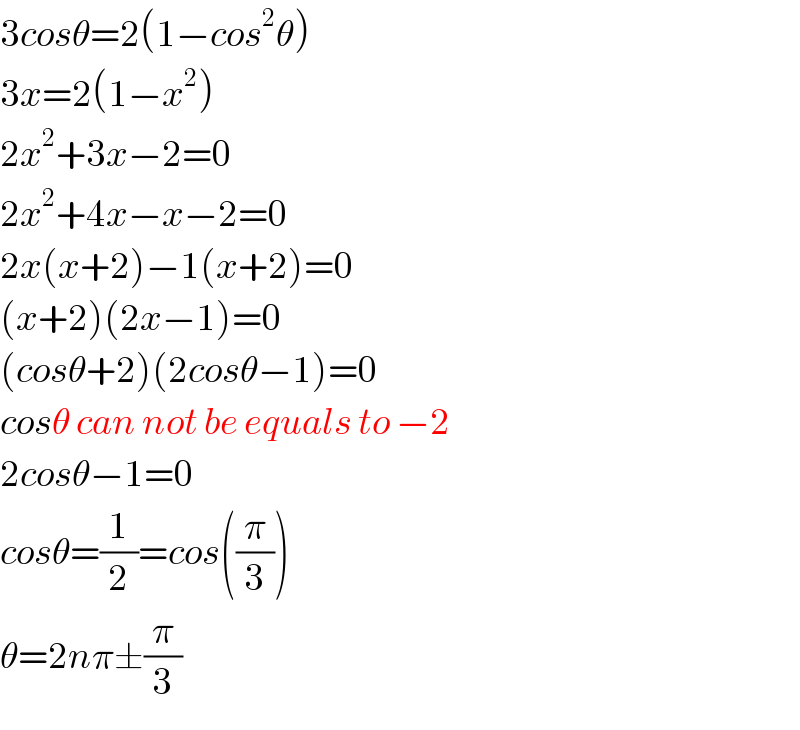
Question and Answers Forum
Question Number 47150 by somil last updated on 05/Nov/18

Commented by maxmathsup by imad last updated on 05/Nov/18
![we see that cosθ must be ≥0⇒θ ∈[−(π/2),(π/2)][2π] changement =x =sinθ give 3(√(1−x^2 ))=2x^2 ⇒9(1−x^2 )=4x^4 ⇒4x^4 +9x^2 −9=0 x^2 =u ⇒4u^2 +9u−9=0 ⇒Δ=9^2 −4.4.(−9) =9(9 +16)=9.25 ⇒(√Δ)=15 u_1 =((−9+15)/8) =(6/8) =(3/4) and u_2 =((−9−15)/8) =−3<0(to eliminate) ⇒ x^2 =(3/4) ⇒x=+^− ((√3)/2) case 1 x=((√3)/2) ⇒sinθ =sin((π/3)) ⇒ θ =(π/3) +2kπ or θ =((2π)/3) +2kπ −(π/2)≤(π/3)+2kπ≤(π/2) ⇒−(1/2)≤(1/3) +2k≤(1/2) ⇒−(5/3) ≤2k≤(1/6) ⇒−(5/6)≤k≤(1/(12)) ⇒k=0 ⇒θ =(π/3) −(π/2)≤((2π)/3) +2kπ≤(π/2) ⇒−(1/2) ≤(2/3) +2k≤(1/2) ⇒((−7)/3) ≤2k≤−(1/6) ⇒ −(7/6)≤k≤−(1/(12)) ⇒k=−1 ⇒x=((2π)/3) −2π =−((4π)/3) and cos(((4π)/3))<0 (toeliminate) case 2 x =−((√3)/2) ⇒sinθ =sin(−(π/3)) ⇒θ =−(π/3) +2kπ or θ=((4π)/3) +2kπ we follow the same manner to find x ...](Q47156.png)
Commented by maxmathsup by imad last updated on 05/Nov/18
![another method but easy (e) ⇔ 3cosθ =2(1−cos^2 θ) ⇒ 3cosθ−2 +2cos^2 θ =0 ⇒2 cos^2 θ +3cosθ −2 =0 with condition cosθ≥0 ⇒ θ ∈[−(π/2),(π/2)] changement cosθ =x drive to 2 x^2 +3x−2 =0 Δ =9−4.2(−2) =9+16 =25 ⇒x_1 =((−3+5)/4) =(1/2) and x_2 =((−3−5)/4) <0(to eliminate) after we solve the equation cosθ =(1/2) ....](Q47158.png)
Answered by tanmay.chaudhury50@gmail.com last updated on 05/Nov/18

